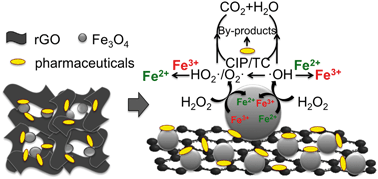Hydrophilic and strengthened 3D reduced graphene oxide/nano-Fe3O4 hybrid hydrogel for enhanced adsorption and catalytic oxidation of typical pharmaceuticals†
Abstract
A simple method for the preparation of a three-dimensional (3D) reduced graphene oxide/Fe3O4 (3D-rGO/Fe3O4) hybrid hydrogel was developed via the reduction of graphene oxide by ferrous ions and in situ simultaneous generation of tunable Fe3O4 nanoparticles on graphene sheets. After drying at 50 °C for 1 h, its mechanical strength was enhanced according to elastic modulus analysis. The hydrophilic and strength-enhanced hybrid was suitable for the removal of two typical pharmaceuticals including ciprofloxacin (CIP) and tetracycline (TC). Their adsorption kinetics, isotherms, pH and cation effects on 3D-rGO/Fe3O4 were studied. The adsorption capacities of 3D-rGO/Fe3O4 were 2.78 mmol g−1 for CIP and 4.76 mmol g−1 for TC according to the Langmuir fitting results, which are much higher than those of commercial granular activated carbons and other graphene-based hydrogels. Moreover, the spent 3D-rGO/Fe3O4 can be easily regenerated by Fenton-like catalytic oxidation with little loss of adsorption capacity after ten adsorption–oxidation cycles. The textural structure and surface functional groups on the adsorbent were hardly changed during the oxidative regeneration process. Benefiting from its superiority, both enhanced adsorption and catalytic degradation of pharmaceuticals were simultaneously achieved using this novel hybrid hydrogel, making it competitive in the removal of micropollutants from water or wastewater.



 Please wait while we load your content...
Please wait while we load your content...